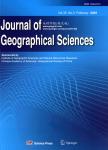Using LiDAR-DEM based rapid flood inundation modelling framework to map floodplain inundation extent and depth
基于高分率LiDAR-DEM数据快速绘制洪水淹没区的范围和深度作者机构:Key Laboratory of Water Cycle and Related Land Surface ProcessesInstitute of Geographic Sciences and Natural Resources ResearchCASBeijing 100101China
出 版 物:《Journal of Geographical Sciences》 (地理学报(英文版))
年 卷 期:2020年第30卷第10期
页 面:1649-1663页
核心收录:
学科分类:08[工学] 081501[工学-水文学及水资源] 0815[工学-水利工程]
基 金:CAS Talents Program and IGSNRR Supporting Fund No.YJRCPT2019-101
主 题:inundation modelling DEM LiDAR floodplain hydraulic remote sensing
摘 要:Mapping floods is important for policy makers to make timely decisions in regards to emergency responses and future *** is therefore crucial to develop a rapid inundation modelling framework to map flood *** study develops an airborne scanning laser altimetry(LiDAR)digital elevation model(DEM)based Rapid flood Inundation Modelling framework(LiDAR-RIM)for assessment of inundation extent,depth,volume and duration for flood *** modelling framework has been applied to the mid-Murrumbidgee region in the southeast Murray-Darling Basin,Australia for two flood events occurred in December 2010 and March *** inundation extents estimated using this methodology compared well to those obtained from two Landsat ETM+images,demonstrating suitability and applicability of this *** testing possibility of larger area application,the framework also uses 30-m resolution shuttle radar topography mission(SRTM)-DEM to replace Li DAR-DEM for the same *** inundation extents obtained by using the SRTM-DEM are smaller than those obtained using the Li DAR-DEM,especially for large flood events.A possible reason is that the river cross sections obtained from the SRTM-DEM are not accurate enough for inundation *** Li DAR-RIM has an advantage for process modelling and scenario modelling under future climatic conditions.




